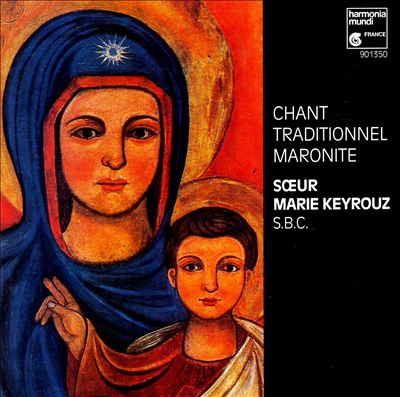 Chant Maronite
Chant Maronite
| 25,00 ą |
-
Schubho-lhaw qolo
01:51
Sister Marie Keyrouz – Schubho-lhaw qolo
-
Tawnimar Toubo
02:07
Sister Marie Keyrouz– Tawnimar Toubo
-
Yawno tlito
02:07
Sister Marie Keyrouz – Yawno tlito
-
Baytun maghara
01:58
Sister Marie Keyrouz – Baytun maghara
-
Hoqtilo Bmecren
01:47
Sister Marie Keyrouz – Hoqtilo Bmecren
-
kanoun
01:30
Sister Marie Keyrouz – kanoun
-
Hallel
01:47
Sister Marie Keyrouz – Hallel
-
Ya Umm Alah
03:19
Sister Marie Keyrouz – Ya Umm Alah
-
Ana-l-ummu hazina
02:41
Sister Marie Keyrouz – Ana-l-ummu hazina
-
Nay
01:56
Sister Marie Keyrouz – Nay
-
Fil-layli
02:33
Sister Marie Keyrouz – Fil-layli
-
Bakkara Abram
01:33
Sister Marie Keyrouz – Bakkara Abram
-
Tishbohto-l-Moryo
02:01
Sister Marie Keyrouz – Tishbohto-l-Moryo
-
Yawmou-l-sharri
01:05
Sister Marie Keyrouz – Yawmou-l-sharri
-
Oud
01:19
Sister Marie Keyrouz – Oud
-
Ayyouha-r-Rabbou
01:39
Sister Marie Keyrouz – Ayyouha-r-Rabbou
-
Taraat amama-Salib
01:46
Sister Marie Keyrouz – Taraat amama-Salib
-
Halleluia
02:54
Sister Marie Keyrouz – Halleluia
-
Qama wa--dhoulmou
01:58
Sister Marie Keyrouz – Qama wa--dhoulmou
-
Inna-lMasih qad qam
02:24
Sister Marie Keyrouz – Inna-lMasih qad qam
This recording, mainly devoted to Maronite traditional singing, also contains a few exemples from the Syrian Christian (Nos. 3, 5) and the Syrian Orthodox (No. 2) repertories.
For the most part, both the melodies and the words go back to the earliest centuries of Christianity and are obviously related to other early chants, both sacred and profane, of the Near and Middle East.
The singing is entirely monodic and almost always strophic and syllabic (the melody composition follows two highly traditional procedures : centonisation (a "patchwork" of pre-existing musical units or formulas) and the adaption of melody-types.
The compass of the melody is very restricted, often limited to a fourth or a fifth, and sometimes even a third.
The melodies always proceed in joint parallel movement. (The intervals of the fourth and the fifth are rare, and larger intervals like the sixth and beyond never exist at all.) The "model" system is of a particular archaic type irreducible to the Arab musical system or to that of the eight Byzantine or Gregorian modes.
The rhythm is varied. Metres of one, two, three, irregular and free five beat divisions occur.
The traditional instrumental accompaniment is limited to four metallic percussion instruments, the use of which is reserved for a number of solemn occasions and to certain joyful liturgical periods (Christmas, Easter, etc...).
The various salient features of traditionnal Maronite Chants prove them to be, after all is said and done, a communal liturgical form of singing, austerely and hieratically monastic in cast, generally calm in character, mderate in tempo, simple in demeanour and straightforward in structure.
It therefore requires a compatible interpretation. Traditionnel Maronite singing is congregational and A Cappella , and the poetry is in syriac (a branch of aramaic).
For several decades, however, it has sometimes been performed (as on this record) according to the conventions of the style of solo singing, at times accompanied by instruments of the Near and Middle East (Ney, Ud, Qanun), and sometimes to recent Arabic texts (Nos.4, 11, 12, 14, 16, 17, 19).
- ←
- 1
- →